Background
The currently used axillary crutch model presents many complications that need to be overcome during use. The axillary crutch transfers a significant amount of force from the patient’s bodyweight to their underarms. This constant pressure on the radial nerve and brachial plexus can result in crutch palsy. Issues arise in patients with weak upper body strength who use crutches while going up and down stairs. The lack of stability along with the forward swing to move results in significant injuries to the user. Similar issues arise when trying to stand up in an area without accessible railings which requires significant balance and strength in the healthy leg. Additionally, slipping due to the bottom of the crutches is also an issue many users face with the currently used crutch model. A newer model can help to minimize these potential risks and reduce further injury to the user.
Problem Statement
A way to address the many difficulties of using crutches in non-weight bearing patients that improves overall safety and usability while reducing risk of further injury.


